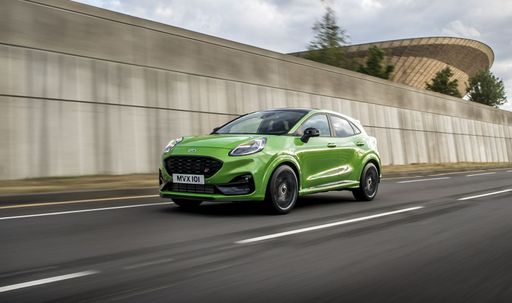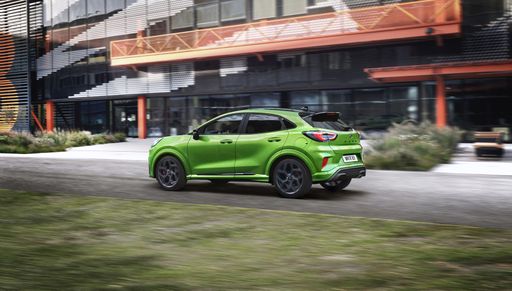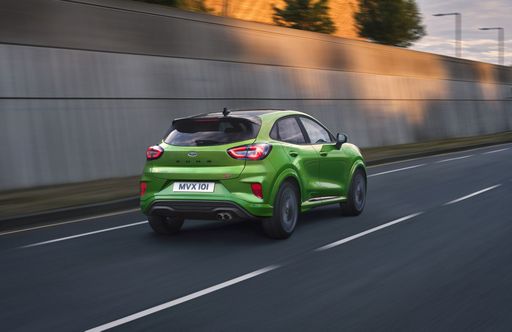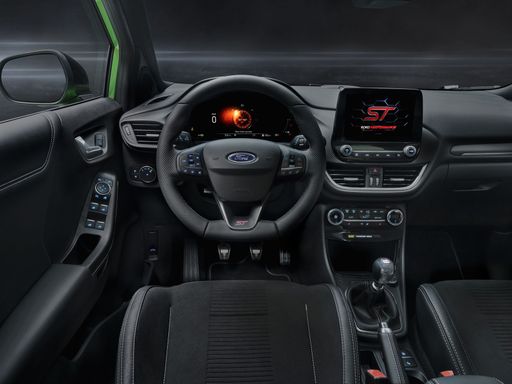Ford Puma VS Ferrari Purosangue – Specs, Efficiency & Price Comparison
Which model is the better choice – the Ford Puma or the Ferrari Purosangue? We compare performance (168 HP vs 830 HP), boot capacity (523 L vs 473 L), efficiency (13.10 kWh5.40 L vs 17.10 L), and of course, the price (24800 £ vs 324700 £).
Find out now which car fits your needs better!
The Ford Puma (SUV) is powered by a Petrol MHEV or Electric engine and comes with a Manuel or Automatic transmission. In comparison, the Ferrari Purosangue (SUV) features a Petrol engine and a Automatic gearbox.
When it comes to boot capacity, the Ford Puma offers 523 L, while the Ferrari Purosangue provides 473 L – depending on what matters most to you. If you’re looking for more power, you’ll need to decide whether the 168 HP of the Ford Puma or the 830 HP of the Ferrari Purosangue suits your needs better.
There are also differences in efficiency: 13.10 kWh5.40 L vs 17.10 L. In terms of price, the Ford Puma starts at 24800 £, while the Ferrari Purosangue is available from 324700 £.
Compare all the key specs now and find out which model fits your lifestyle best!
Ford Puma
The Ford Puma presents itself as a stylish compact SUV with a distinctive design that combines practicality with a dynamic driving experience. Its sleek lines and sporty aesthetics make it stand out on the road, while the interior offers a comfortable and tech-savvy environment. With an emphasis on efficiency and a smooth drive, the Ford Puma is well-suited for both urban commutes and countryside adventures.
details @ puma.fordpresskits.com
@ puma.fordpresskits.com
 @ puma.fordpresskits.com
@ puma.fordpresskits.com
 @ puma.fordpresskits.com
@ puma.fordpresskits.com
 @ puma.fordpresskits.com
@ puma.fordpresskits.com
Ferrari Purosangue
The Ferrari Purosangue marks the brand's first venture into the SUV segment, combining the luxury and performance synonymous with the Italian manufacturer. Its sleek design and powerful engine deliver a driving experience that is both exhilarating and refined. Inside, the Purosangue offers a sumptuous interior that perfectly balances sportiness with comfort, ensuring it stands out in the competitive luxury SUV market.
details

|
|
|
|
|
Costs and Consumption |
|
|---|---|
|
Price
24800 - 36300 £
|
Price
324700 £
|
|
Consumption L/100km
5.4 - 6 L
|
Consumption L/100km
17.10 L
|
|
Consumption kWh/100km
13.1 - 13.7 kWh
|
Consumption kWh/100km
-
|
|
Electric Range
364 - 376 km
|
Electric Range
-
|
|
Battery Capacity
43 kWh
|
Battery Capacity
-
|
|
co2
0 - 136 g/km
|
co2
389 g/km
|
|
Fuel tank capacity
42 L
|
Fuel tank capacity
100 L
|
Dimensions and Body |
|
|---|---|
|
Body Type
SUV
|
Body Type
SUV
|
|
Seats
5
|
Seats
4
|
|
Doors
5
|
Doors
5
|
|
Curb weight
1316 - 1563 kg
|
Curb weight
2033 kg
|
|
Trunk capacity
456 - 523 L
|
Trunk capacity
473 L
|
|
Length
4186 - 4226 mm
|
Length
4973 mm
|
|
Width
1805 mm
|
Width
2028 mm
|
|
Height
1550 - 1555 mm
|
Height
1589 mm
|
|
Payload
367 - 469 kg
|
Payload
-
|
Engine and Performance |
|
|---|---|
|
Engine Type
Petrol MHEV, Electric
|
Engine Type
Petrol
|
|
Transmission
Manuel, Automatic
|
Transmission
Automatic
|
|
Transmission Detail
Schaltgetriebe, Automat. Schaltgetriebe (Doppelkupplung)
|
Transmission Detail
Automat. Schaltgetriebe (Doppelkupplung)
|
|
Drive Type
Front-Wheel Drive
|
Drive Type
All-Wheel Drive
|
|
Power HP
125 - 168 HP
|
Power HP
830 HP
|
|
Acceleration 0-100km/h
7.4 - 9.8 s
|
Acceleration 0-100km/h
3.30 s
|
|
Max Speed
160 - 210 km/h
|
Max Speed
312 km/h
|
|
Torque
170 - 290 Nm
|
Torque
692 Nm
|
|
Number of Cylinders
3
|
Number of Cylinders
12
|
|
Power kW
92 - 124 kW
|
Power kW
533 kW
|
|
Engine capacity
999 cm3
|
Engine capacity
6496 cm3
|
General |
|
|---|---|
|
Model Year
2024 - 2025
|
Model Year
2023
|
|
CO2 Efficiency Class
D, E, A
|
CO2 Efficiency Class
G
|
|
Brand
Ford
|
Brand
Ferrari
|
Ford Puma
A Glimpse into the Ford Puma: Fusing Style with Innovation
The Ford Puma stands as a testament to modern engineering fused with style. This compact SUV is not just about aesthetics but brings to the table an array of technical innovations, topped with the reliability and performance Ford is known for. Let's delve into the technical specifics and innovative features that make the Ford Puma a stellar choice for any car enthusiast.
Powertrains and Performance
The Ford Puma is offered with a range of powertrains designed to deliver optimal performance whilst minimising fuel consumption. At the heart of this compact SUV is the 1.0 EcoBoost Hybrid engine, available in both 125 PS and 155 PS variants. This engine is a marvel of engineering, optimised to deliver power efficiently with a remarkable fuel consumption ranging from 5.4 to 5.7 L/100km for manual versions, and slightly higher for the automated variants.
The top-end 1.5 EcoBoost ST variant takes performance up a notch, providing a robust 200 PS that propels the Puma from 0 to 100 km/h in just 6.7 seconds. This variant is perfect for those who prioritise performance and exhilaration in their driving experience.
Mild-Hybrid Technology
The Puma's mild-hybrid technology plays a significant role in enhancing fuel efficiency and reducing emissions. By utilising a belt-driven integrated starter/generator, the Puma recovers energy usually lost during braking, storing it in a 48-volt lithium-ion battery. This stored energy is then used to assist the engine, providing a boost during acceleration and smoothing out the stop-start technology, ultimately leading to enhanced fuel efficiency.
Design and Comfort
The Ford Puma does not compromise on style and comfort with its ergonomic and stylish design. The SUV is available in multiple trims including the ST-Line, Titanium, and the luxurious Vignale editions, each offering unique aesthetic and technological enhancements. These trim levels provide varied offerings in terms of both exterior styling and interior comfort, ensuring there's a Puma that meets every personal preference.
Inside, the Puma offers a driver-focused cockpit with advanced technological integrations such as the SYNC 3 infotainment system, providing seamless connectivity and intuitive control of the vehicle's numerous technological features.
Safety and Technology
Safety remains paramount, and the Ford Puma is equipped with the latest security and technology features. It boasts the Ford Co-Pilot360 suite which includes adaptive cruise control, pre-collision assist with autonomous emergency braking, and lane-keeping assist, enabling a safer driving experience on both city roads and highways.
Versatility and Practicality
Beyond performance and safety, the Ford Puma shines in its versatility. With a boot capacity of 456 litres, it offers ample space for all sorts of adventures, whether you're heading on a family trip or loading sports equipment. Its innovative MegaBox is an extra storage solution, providing additional space below the boot floor.
The Puma's agile handling, paired with its compact dimensions—spanning a length of 4186 to 4266 mm and a width of 1805 mm—makes it an ideal choice for urban commuting and beyond.
Conclusion
In conclusion, the Ford Puma beautifully blends practical features with cutting-edge technology, offering a package that appeals to both the tech-savvy driver and those seeking comfort and reliability. Its range of innovative features, powerful yet efficient engine options, and a design that is both functional and stylish make it a frontrunner in the compact SUV market.
Whether you're drawn by the efficient mild-hybrid engines or the robust performance of the ST variant, the Ford Puma represents a modern driving experience where innovation meets everyday usability.
Ferrari Purosangue
Introduction to the Ferrari Purosangue
In an ambitious blend of performance, luxury, and innovation, the Ferrari Purosangue marks Ferrari's first venture into the SUV segment. This groundbreaking vehicle merges the legendary Ferrari essence with the versatility and comfort of an SUV, delivering a driving experience like no other.
Design and Elegance
The Ferrari Purosangue is a visual masterpiece with dimensions that complement its formidable performance capabilities. Its sleek 4973 mm length, 2028 mm width, and 1589 mm height establish an imposing presence on the road. This elegantly crafted SUV combines aerodynamic efficiency with Ferrari's signature aesthetic, ensuring it turns heads wherever it goes.
Powertrain and Performance
At the heart of the Purosangue lies a commanding 6.5-litre V12 engine, producing an intense 830 PS (533 kW) and 692 Nm of torque. This powerhouse propels the Purosangue from 0 to 100 km/h in a mere 3.3 seconds and reaches a top speed of 312 km/h, exemplifying the raw power and throttle response expected from Ferrari. Paired with an automatic transmission featuring a dual-clutch system, the Purosangue shifts with precision, providing seamless acceleration and optimal performance.
Advanced All-Wheel Drive System
The Purosangue's sophisticated all-wheel-drive system ensures impeccable traction across varying terrains, combining control and stability to enhance the driving experience. This capability brings a new level of versatility, enabling drivers to venture beyond traditional sports car limits without sacrificing the thrill of a Ferrari.
Innovative Features and Technology
Inside, the Ferrari Purosangue is equipped with cutting-edge technology designed to provide both comfort and functionality. The interior is a blend of advanced digital interfaces and classic Ferrari craftsmanship, offering four luxurious seats and state-of-the-art infotainment options. The driving dynamics can be customised via the advanced driving mode settings, ensuring adaptability to driver preferences and road conditions.
Environmental Considerations
Despite its remarkable performance, the Purosangue also pays attention to environmental factors. With a fuel consumption of 17.1 L/100km and CO2 emissions at 389 g/km, the Purosangue seeks a balance between power and environmental responsibility. However, it holds a CO2 efficiency class of G, indicating the challenge of achieving lower emissions within the high-performance SUV market.
Conclusion
The Ferrari Purosangue redefines the luxury SUV market, presenting an unmatched blend of performance, style, and versatility. Through innovative engineering and Ferrari's iconic design language, it offers a driving experience that remains true to the brand's illustrious heritage. For those seeking a unique combination of SUV practicality and Ferrari performance, the Purosangue sets a new benchmark in automotive excellence.
The prices and data displayed are estimates based on German list prices and may vary by country. This information is not legally binding.
